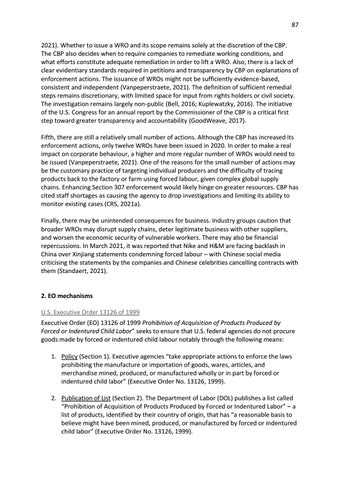87 2021). Whether to issue a WRO and its scope remains solely at the discretion of the CBP. The CBP also decides when to require companies to remediate working conditions, and what efforts constitute adequate remediation in order to lift a WRO. Also, there is a lack of clear evidentiary standards required in petitions and transparency by CBP on explanations of enforcement actions. The issuance of WROs might not be sufficiently evidence-based, consistent and independent (Vanpeperstraete, 2021). The definition of sufficient remedial steps remains discretionary, with limited space for input from rights holders or civil society. The investigation remains largely non-public (Bell, 2016; Kuplewatzky, 2016). The initiative of the U.S. Congress for an annual report by the Commissioner of the CBP is a critical first step toward greater transparency and accountability (GoodWeave, 2017). Fifth, there are still a relatively small number of actions. Although the CBP has increased its enforcement actions, only twelve WROs have been issued in 2020. In order to make a real impact on corporate behaviour, a higher and more regular number of WROs would need to be issued (Vanpeperstraete, 2021). One of the reasons for the small number of actions may be the customary practice of targeting individual producers and the difficulty of tracing products back to the factory or farm using forced labour, given complex global supply chains. Enhancing Section 307 enforcement would likely hinge on greater resources. CBP has cited staff shortages as causing the agency to drop investigations and limiting its ability to monitor existing cases (CRS, 2021a). Finally, there may be unintended consequences for business. Industry groups caution that broader WROs may disrupt supply chains, deter legitimate business with other suppliers, and worsen the economic security of vulnerable workers. There may also be financial repercussions. In March 2021, it was reported that Nike and H&M are facing backlash in China over Xinjiang statements condemning forced labour – with Chinese social media criticising the statements by the companies and Chinese celebrities cancelling contracts with them (Standaert, 2021).
2. EO mechanisms U.S. Executive Order 13126 of 1999 Executive Order (EO) 13126 of 1999 Prohibition of Acquisition of Products Produced by Forced or Indentured Child Labor” seeks to ensure that U.S. federal agencies do not procure goods made by forced or indentured child labour notably through the following means: 1. Policy (Section 1). Executive agencies “take appropriate actions to enforce the laws prohibiting the manufacture or importation of goods, wares, articles, and merchandise mined, produced, or manufactured wholly or in part by forced or indentured child labor” (Executive Order No. 13126, 1999). 2. Publication of List (Section 2). The Department of Labor (DOL) publishes a list called “Prohibition of Acquisition of Products Produced by Forced or Indentured Labor” – a list of products, identified by their country of origin, that has “a reasonable basis to believe might have been mined, produced, or manufactured by forced or indentured child labor” (Executive Order No. 13126, 1999).













